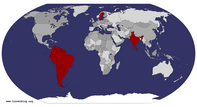Advertisement
Published: February 24th 2008

 Me
Me
in sareeSaree
Most women in Sri Lanka wear it, at least when they are going to town. After making sure I was not offending anyone of any cultural rules, I decided I was gonna meet my sweetheart in one. Which i did. I had to get up extra early to get help to get myself pinned in properly. But Markus smiling face was reward enough. When temperature was increasing towards nine, ten however, I decided to end my saree experience, as it gets really hot! Wearing one now impresses me even more, because I know what the women have to put up with, sitting not to wrinkle, moving not to step on the saree and fall, and avoiding fainting from heat exhaustion! We continued to Dehivala zoo, the only zoo in Sri Lanka, which is pretty good when it comes to developing country standars. I was expecting to see much more misery... which was a pleasant surprise. Then we headed south.
The Coast - hatcheries
Turtle hatcheries line the south west coast of Sri Lanka, and since I heard about them I have been determined to visit them to find out more about the conservation and information they

 Railways
Railways
...are the pedestrain walks of Sri Lankaprovide. Markus did not deny me this, and in the area of Kosgoda we managed to visit three of varying quality.
Turtle hatcheries rely on the illegal service of fishermen bringing the eggs directly from the beach, where they have been laid. Hatching success decreases if they are moved after three hours of laying. The hatcheries apparently have people working in the night, to recieve the eggs from the egg collectors right after the female has dropped them in her egg chamber. "We do not buy eggs that are older than three hours". And how can they make that sure? "There is a dark spot if it is older than three hours". - So they check every egg? They said they don't buy if it is older than three hours.
The eggs are reburried in enclosed sand, at the eleged depth that turtles dig their chambers. After between 48 to 60 days they hatch and are put in tanks for about three days to "allow the navel to close"
They do not feed them, as everyone know "they do not eat during their first week". There were tanks for each of the ages. In the tank with the one

 Ceylon tea
Ceylon tea
... all around me!day old hatchlings there was high activity, almost all of them were swimming. In the second there was still alot of paddling, but in the third tank, the three day old hatchlings were mostly relaxing, laying with their flippers locked on top of the shell. This very clearly illustrates the so called "juvenile frenzy" which goes on for between 24 to 48 hours, where they paddle their flippers constantly with the intent to reach the pelargic ocean, and start drifting with the currents.
On the third day some chosen lucky tourists are allowed to "release the turtles to the sea". Always at dusk, always at the same place. The reef fishes must be pretty grateful to their terrestrial dinner provider's punctuality by now. There was a couple releasing turtles, and the lady was utterly delighted to see her baby turtles dissappearing into the waves. They were releasing olive ridleys and green turtles. Some turtles were very still, either exhausted or reading their new environment, the lady was busy with all her new darlings and she was always making sure that they all were facing the ocean. Me and Markus, being the biologists we are, were curious to see if

 World's end
World's end
Me at Sri Lanka's World's endthey would orientate toward the ocean even if they were placed with the tail facing the ocean. After twenty trials or so, we concluded that they did. Maybe it was the tilt of the beach or the sound of the ocean, but something made them all turn, and head for the soft waves. However wondruous the moment may have seemed to the couple it was still not as great for us. Knowing that the "juvenile frenzy" had been stolen from them, how will they make it to the pelargic?
There was however a place which was somewhat better than the worst, where they said that low sand temperature creates a mayority of females, and high creates a mayority of males. This is true for crocodiles, but for turtles it is the opposite. This was a nail in my eye for at least the rest of our evening. Dudley's place however was slightly better than the other hatcheries. There no human interaction with the turtles was allowed, and only five percent were kept to educate the public, the other hatchlings were released on the same night they emerge from the sand. On different times, and on different spots, in that

 Fruitbats
Fruitbats
also known as flying foxesmanner, trying to fool the reef fishes!
Beautiful hill country
Slow trains and perfect scenery, the hill country is full of it. And most of all - tea. We really like Ella, as do many other tourists, that is where we saw the people walking on the railway tracks. And a multitude of multicolored scarfed women in the green tea fields. Horton Plains National Park with the World's End was great to see before the clouds started rolling in over the valley at around nine o'clock. We had coconuts and curries, and buffalo milk curd, and tea - off course! We endulged in the diverse habitats of Sri Lanka and got up early in the mornings to see sunrises and to go bird watching. We went snorkelling in rivers and planted trees in a rain forest. With a delight we added the endemic birds and fish to our fauna lists.
During a night game watch we saw sleeping snakes and lizards, mating stick insects and strange long-legged centipeds. In kandy we went to the impressive botanical garden. Markus was happy to do bird watching were as I was silently swearing over the lack of signs telling names

 Flipper
Flipper
two days old perhaps?of the gianty trees. There was good bird wathing and we saw oreol's i courtship, nest-building munia's, and a resting Koel. There we also saw thousands of bats! Flying foxes...
Before heading to the coast again we managed to squeeze in a couple of cultural additons too. The Dambulla caves temples were impressive, as was the scenery from the Sigiria Rock. We passed Anuradhapura and experienced some heavy military controls. The day before they had found a bomb in the market place, five minutes before it would have blown up. Security was tightened and busses were checked going in, and out of the city. All baggages on a buss needed the claim from its owner. Any owner announcing himself delayed gave gave us an unpleasant feeling in the stomach. But baggage was being checked regardless of owner being there or not. I know I was a bit jumpy when it came to suspiscous luggage. Reaching Puttalam we were at the coast, and careless thoughtless tuc tuc drivers tried to scare us to take a ride with them by saying "there's a bomb on the bus!" Off course then, we HAD to take the bus. No silly tuc tuc driver

 On the sea
On the sea
Pirates of the Carrebean IV?was gonna think THAT was a good idea to get customers!
Rescue boat in Kalpitiya
Accidental capture or "by-catch" of marine turtles in fishing operations worldwide is one of the mayor threats to their survival. Turtles need to surface for air or they will drown. Fish and turtles aggregate at the Gulf of Mannar, the gulf between Sri Lanka and India, and so do the fishermen. According to a survey done by TCP this is were the highest by-catch mortality of Sri Lanka is found, and suitably they have a rescue boat operating from the sleeping harbour town of Kalpitiya.
On the first day there, we crossed the laggon, through the mangroves and visited a small fishing village which I do not know the name of. We went there because the site manager knew it is poor and that they continuously cath and eat turtles. It is a resource from the ocean - if they catch it they eat it. The arms of the law don't reach these villages, in fact the arms of the law in this country only reaches far enough to a money filled pocket. Finding a cop that is not corrupt is

 Tuna
Tuna
Brutal truthprobably as hard as finding a Sri Lankan meal without chilli, pretty darn difficult. So even though any harm to marine turltes has been forbidden since 1972, killing and eating them for meat is still a reality of life. We found quite alot of turtle killing evidence. Shells, skulls and a flipper, still with flesh on. Guess the dogs or pigs hadn't found that one yet. The site manager said that it used to be more plentiful just a couple of years ago. He could not answer the question if that was due to the villagers were killing fewer, or just the fact that there are fewer to be killed.
The next day we got up at four, had a banana and prepared with an anti sea-sickness tablett. It was a calm and beautiful morning as the boat set out at dawn to start a day of turtle rescue. Normally the boat only goes out when there are lots of fisherman out, however although middle in the flying fish season, not many fishermen reported they had plans togo out the nearest days. But here we were, fishermen or not, we'd go out! This off course turned out to be

 Is it a bird or an aeroplane?
Is it a bird or an aeroplane?
Is it superman... no it's a flying fish!rather fruitless, in turtle rescue manner. However very good indeed because then there were less suffering turtles. We spotted some fishermen, among them an illegal indian fishing boat. They tried to bride our silence with some ground nuts, however as soon as we got network the site manager called the navy to let them know about the unlawful vessel. We saw yellow-finned tuna being caught and hammered before getting dragged up into the boat. Flying fish was the main reason for the fishing boats we saw, and with our small motor boat of maybe five or six meters we scared off quite a few. It is an elegant mode of travelling, for a fish.
Deciding this was the end of the day at about 11 we headed toward land again. We were 30 km out, and had to use compass to make sure we were getting back to the right place. land was out of sight. All of a sudden Markus exclaims "turtle". He hadreally spotted a turtle just swimming in the ocean, an olive ridley who had found some adrift flying fish to play with. Everybody in the boat were ordered to get down into the boat, and the TCPstaff started clapping the hands on the boat trying to attract the turtle through vibration and curiosity. If it works with some turtles. we'll never know, it didn't work with this one. After some tries, she decided she had enough and dove down into the depths of the ocean.
HUh, this was a long blog, i will have to continue in the next entry. Then I will tell you about when we were eye to eye with an armed egg poacher... Tomorrow I go to India, in hope to see tha arribada in Orissa!!!
Advertisement
Tot: 0.153s; Tpl: 0.012s; cc: 11; qc: 49; dbt: 0.0531s; 1; m:domysql w:travelblog (10.17.0.13); sld: 1;
; mem: 1.2mb








